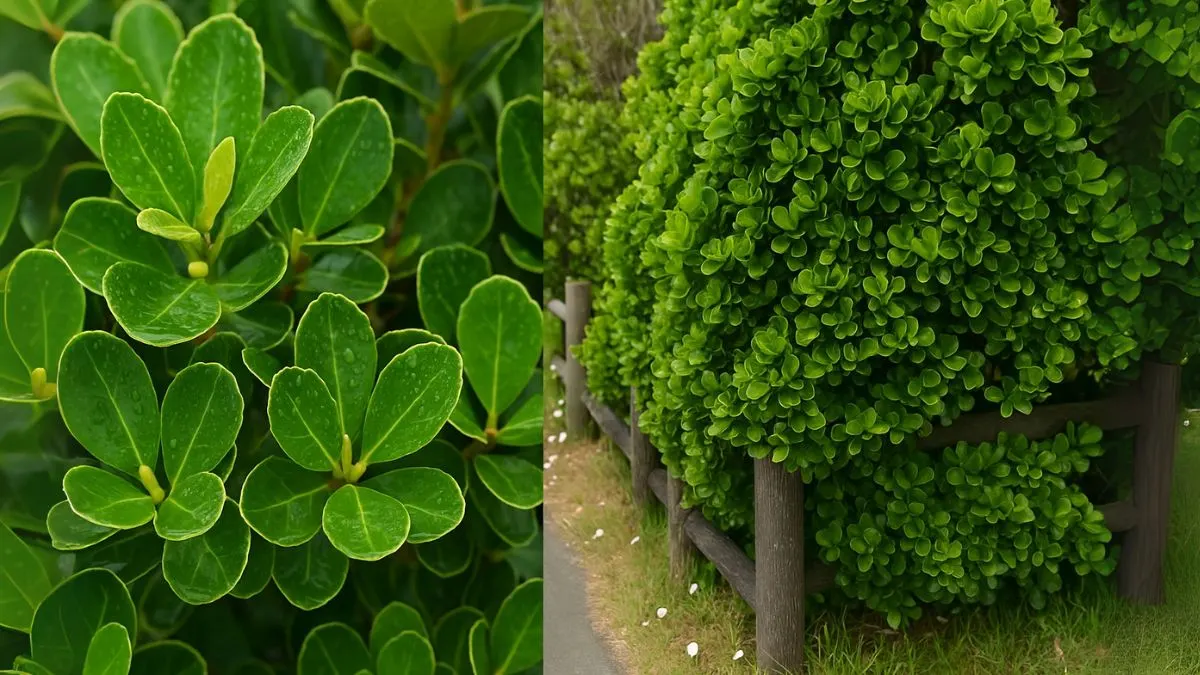The Japanese Spindle Tree is a striking plant that instantly adds structure and greenery to any garden. Known botanically as Euonymus japonicus, it’s admired for its glossy leaves and resilience. However, while gardeners love its beauty, there’s another side to it—it’s also notorious for being toxic for humans and pets alike.
I first encountered this plant in a neighbor’s garden in Toronto. Its lush form looked incredible as a hedge, but I learned quickly that despite its ornamental appeal, it’s not a plant you’d want pets or children nibbling on.
Growth and Appearance

- It is an evergreen shrub or small tree growing to 2–8 m (6 ft 7 in–26 ft 3 in) tall, with opposite, oval leaves 3–7 cm long with finely serrated margins.
- Some specimens can grow up to 10 meters tall, particularly in ideal conditions.
- Its dense, shiny foliage makes it an excellent choice for hedges, topiary, or standalone ornamental plants.
This hairless, evergreen shrub or small tree is not only hardy but also visually striking, which explains why it’s popular in Canada, the USA, and worldwide.
Ornamental Value
Gardeners often plant the Japanese Spindle Tree because:
- Euonymus Japonicus is a flowering plant that is used for ornamental purposes in parks and landscapes.
- Its flowers may not be show-stopping, but its evergreen foliage ensures year-round appeal.
- The Japanese Spindletree is a showy flowering evergreen plant, often chosen for its formal look in manicured gardens.
In my experience, it thrives best along property boundaries, forming a natural privacy screen that’s both elegant and practical.
Also Read: How to Grow Poppies From Seed (and Get Gorgeous Flowers!)
Toxicity Concerns
Despite its beauty, the Japanese Spindle Tree requires caution.
- It is notorious for being toxic for humans and pets alike.
- Ingestion can cause stomach upset, nausea, and other health problems.
- Pet owners, especially dog and cat parents, should avoid planting it where curious pets might chew on the leaves or stems.
This dual nature—beautiful but potentially dangerous—means gardeners must weigh its ornamental value against safety concerns.
Vulnerability to Pests and Diseases
Although hardy, the plant has weaknesses:
- It is damaged by a wide range of insects, pathogens and nematodes.
- Common pests include scale insects, aphids, and spider mites.
- Fungal leaf spots and mildew can also appear in damp or poorly ventilated areas.
Regular monitoring and well-drained soil can reduce the risk. I learned this firsthand when my friend’s spindle hedge was attacked by scale insects—it required both pruning and organic treatments to recover.
Quick Care Guide
Here’s a handy table for caring for the Japanese Spindle Tree:
Care Aspect |
Requirement |
Height |
2–8 m tall, can grow up to 10 meters |
Leaves |
Opposite, oval leaves 3–7 cm long with finely serrated margins |
Type |
Hairless, evergreen shrub or small tree |
Use |
Euonymus Japonicus is a flowering plant that is used for ornamental purposes |
Risk |
Notorious for being toxic for humans and pets alike |
Weakness |
Damaged by a wide range of insects, pathogens and nematodes |
Why It’s Famous Worldwide
- In Canada and the USA, homeowners use it in landscapes, despite the extra pest management needed.
- In Japan, its native habitat, it’s a cultural and natural element in traditional gardens.
- Globally, landscapers appreciate it for being a showy flowering evergreen plant that stays lush throughout the seasons.
Even with its drawbacks, its structured look makes it a gardener’s favorite in both private homes and public spaces.
Also Read: Why Aglaonema Evergreen Is the Perfect Indoor Plant for Beginners
Personal Perspective: A Plant with Dual Nature
When I planted my first Euonymus hedge, I was captivated by how quickly it formed a lush, green wall. The downside? It needed more pest control than I had expected. And because it’s toxic for humans and pets alike, I had to plant it far away from my dog’s play area.
This taught me that while the Japanese Spindle Tree is undeniably stunning, it’s best suited for gardeners who can commit to a little extra care and caution.
Should You Grow the Japanese Spindle Tree?
The Japanese Spindle Tree is:
- A hairless, evergreen shrub or small tree with strong ornamental value.
- Euonymus Japonicus is a flowering plant that is used for ornamental purposes, admired for its foliage.
- It can grow up to 10 meters tall and thrives as hedges or decorative screens.
- However, it is notorious for being toxic for humans and pets alike.
- It also is damaged by a wide range of insects, pathogens and nematodes, requiring careful maintenance.
👉 If you’re looking for a showy flowering evergreen plant with structure and elegance, the Japanese Spindle Tree is worth considering—but only if you’re mindful of its toxic nature and pest sensitivities.






